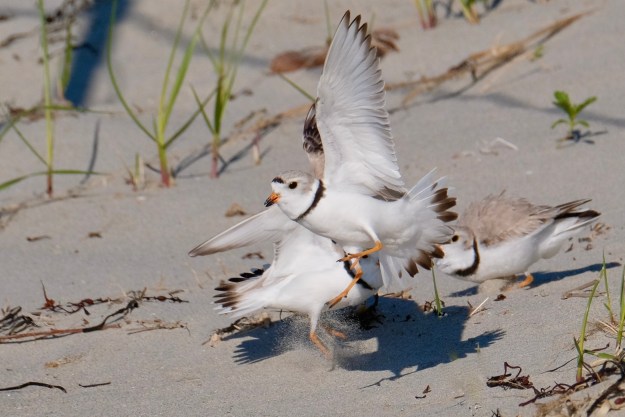Dear Piping Plover Friends,
I hope you are having a joyous holiday season. If you live in the area, please be sure not to miss Gloucester’s Lobster Trap Tree. It’s extra magnificent this year, with 400 traps to honor Gloucester’s 400th anniversary. The tree is fancifully decorated with hundreds of buoys hand painted by local kids. Very generously, the traps for the tree were permanently given to the community by Jim Knott, CEO of Riverdale Mills, with the labor for making the traps donated by Brooks Trap Mill. Every year the tree is built by David Brooks, Shawn Henry and a fantastic group of local volunteers.
The clip is of a young Plover chick and his Dad. I love watching the little ones pop up from the warming wings of an adult. You never know what direction they are going to zoom off to but often enough, they stretch their tiny developing winglets and give a yawn after emerging from thermo-snuggling.
This is just one of hundreds of clips from our forthcoming documentary. Film finishing editing is going beautifully and we are planning to have a cut ready to submit to festivals in January.
Please consider making an end of the year tax deductible donation to our ongoing film funding efforts. Your contribution goes directly to the cost of finishing the film and is absolutely invaluable!
Donate here to our Network for Good online fundraiser .
We are deeply appreciative of every gift given, small and large. For large contributions, your name and organization’s logo is prominently displayed at the beginning and end of the film, with opportunities for up to 30 second promotional spots. Please feel free to call or write with any questions regarding sponsorship.
With gratitude to the following PiPl friends for their kind contributions – Alice and David Gardner (Beverly), JoeAnn Hart (Gloucester), Kim Tieger (Manchester), Joanne Hurd (Gloucester), Holly Niperus (Phoenix), Bill Girolamo (Melrose), Claudia Bermudez (Gloucester), Paula and Alexa Niziak (Rockport), Todd Pover (Springfield), Cynthia Dunn (Gloucester), Nancy Mattern (Albuquerque), Marion Frost (Ipswich), Cecile Christianson (Peabody), Sally Jackson (Gloucester), Donna Poirier Connerty (Gloucester), Mary Rhinelander (Gloucester), Jane Hazzard (Georgetown), Duncan Holloman (Gloucester), Karen Blandino (Rockport), Duncan Todd (Lexington), Sue Winslow (Gloucester), Amy Hauck-Kalti (Ohio), JoAnn Souza (Newburyport), Karen Thompson (San Francisco), and my sweet husband Tom 🙂
Thank you so very much for your support and for seeing the tender beauty in the life story of the Piping Plover.
Very best wishes,
xxKim













































































































